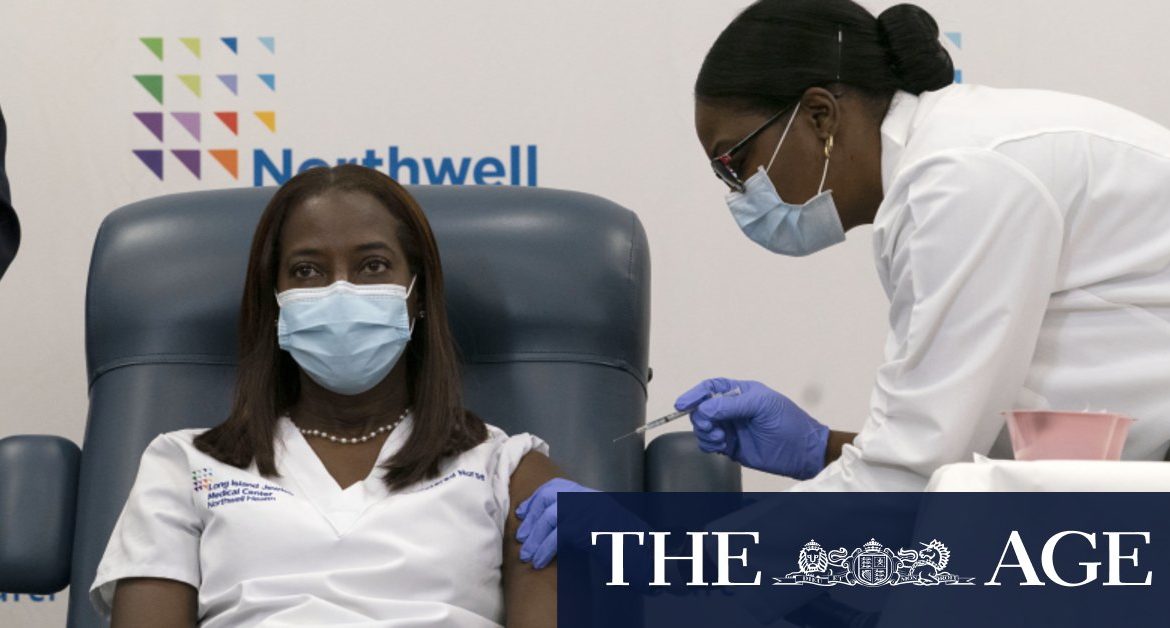Minutes after Lindsay received the injection, President Donald Trump sent a tweet: “First Vaccine Administered. Congratulations USA! Congratulations WORLD!”
Several other countries also have approved the vaccine, including the UK, which started vaccinating last week.
For healthcare workers who, along with nursing home residents, will be first in line for vaccination, hope is tempered by grief and the sheer exhaustion of months spent battling a coronavirus that still is surging in the US and around the world.
“This is mile 24 of a marathon. People are fatigued. But we also recognise that this end is in sight,” said Dr Chris Dale of Swedish Health Services in Seattle.
Packed in dry ice to stay at ultra-frozen temperatures, the first of nearly 3 million doses being shipped in staggered batches this week made their way by truck and by plane around the country on Sunday from Pfizer’s Kalamazoo, Michigan, factory. Once they arrive at distribution centres, each state directs where the doses go next.
Some hospitals across the country spent the weekend tracking their packages, refreshing FedEx and UPS websites for clues.
More of the Pfizer-BioNTech vaccine will arrive each week. And later this week, the FDA will decide whether to green light the world’s second rigorously studied COVID-19 vaccine, made by Moderna.
Now the hurdle is to rapidly get vaccine into the arms of millions, not just doctors and nurses but other at-risk health workers such as cleaners and food handlers – and then deliver a second dose three weeks later.
“We’re also in the middle of a surge, and it’s the holidays, and our healthcare workers have been working at an extraordinary pace,” said Sue Mashni, chief pharmacy officer at Mount Sinai Health System in New York City.
Plus, the shots can cause temporary fever, fatigue and aches as they rev up people’s immune systems, forcing hospitals to stagger employee vaccinations.
A wary public will be watching closely to see whether health workers embrace vaccination. Just half of Americans say they want to get vaccinated, while about a quarter don’t and the rest are unsure, according to a recent poll by The Associated Press-NORC Centre for Public Health Research.
The FDA, considered the world’s most strict medical regulator, said the Pfizer-BioNTech vaccine appears safe and strongly protective – and laid out the data behind it in a day-long public meeting last week for scientists and consumers alike to see.
“Please people, when you look back in a year and you say to yourself, ‘Did I do the right thing?’ I hope you’ll be able to say, ‘Yes, because I looked at the evidence’,” Dr Francis Collins, director of the National Institutes of Health, said on Sunday on NBC’s Meet the Press. “People are dying right now. How could you possibly say, ‘Let’s wait and see’.”
Still, emergency use means the vaccine was cleared for widespread use before a final study in nearly 44,000 people is complete – and that research is continuing to try to answer additional questions.
Loading
While effective against COVID-19 illness, it’s not yet clear if vaccination will stop the symptomless spread that accounts for half of all cases.
The shots still must be studied in children, and during pregnancy. But the American College of Obstetricians and Gynecologists said late on Sunday that vaccination should not be withheld from pregnant women who otherwise would qualify.
While the vaccine was determined to be safe, regulators in the UK are investigating several severe allergic reactions. The FDA’s instructions tell providers not to give it to those with a known history of severe allergic reactions to any of its ingredients.
AP
Get our Coronavirus Update newsletter
Stay across the news you need to know related to the pandemic. Sent Monday and Thursday. Sign up here.
Most Viewed in World
Loading







